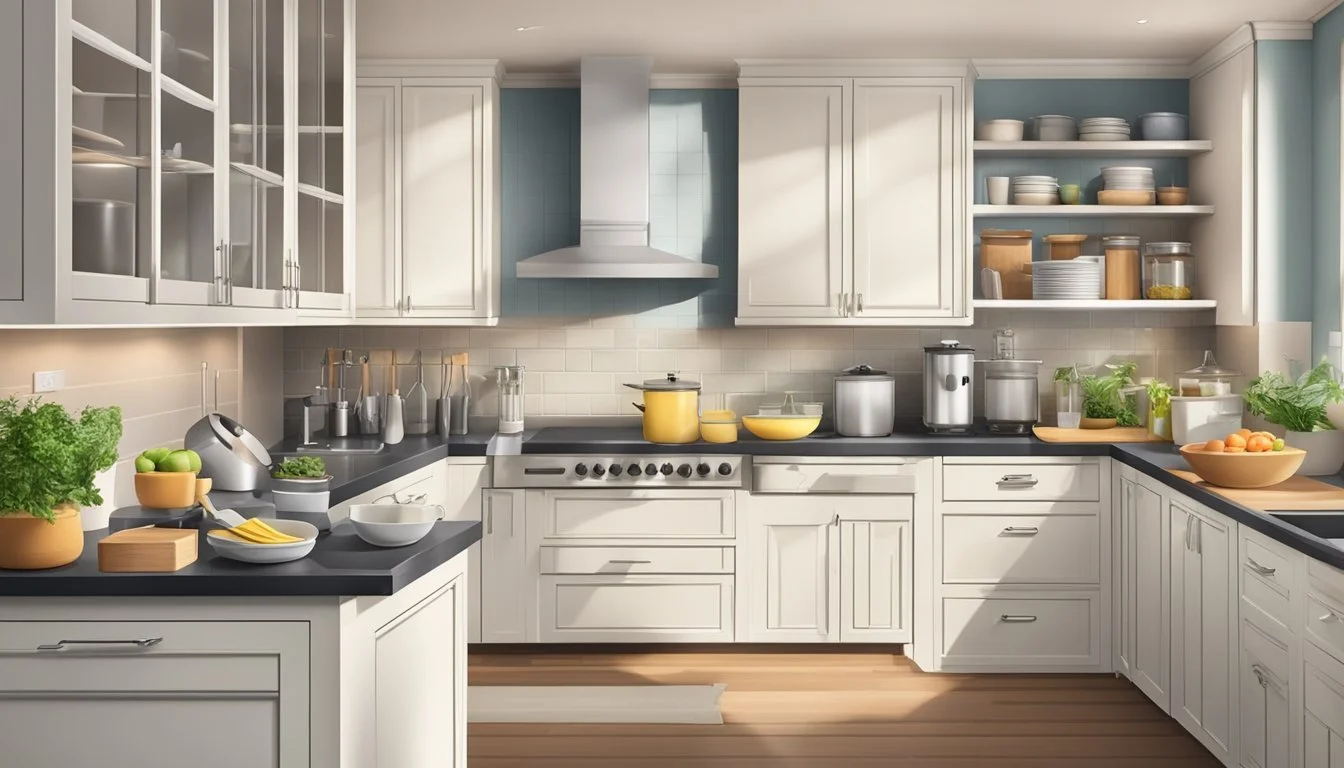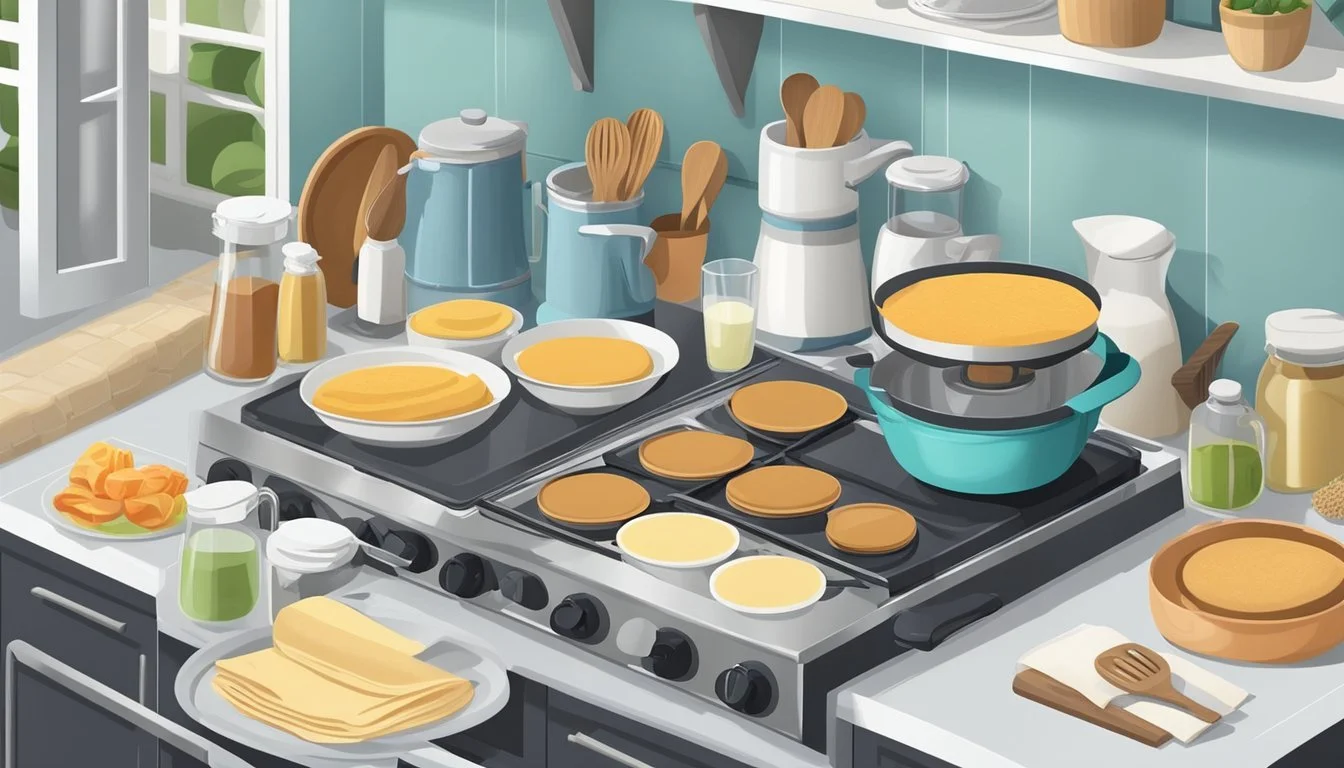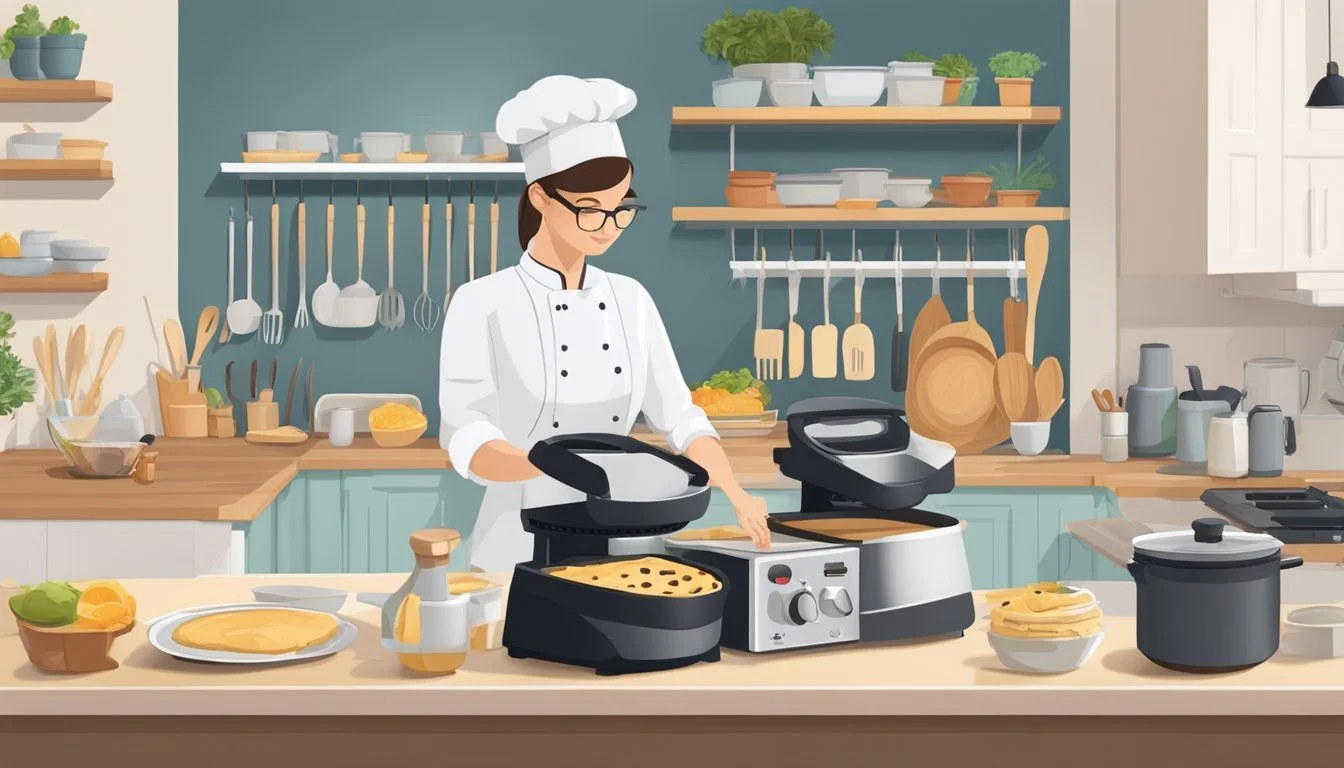5 Tips for Organizing Your Kitchen for a Dinner Party with a Crepe Maker
Streamline Your Space for Flawless Entertaining
When hosting a dinner (What wine goes well with dinner?) party, the kitchen becomes the command center for culinary delights and organization is key to ensuring a smooth and enjoyable experience for both the host and the guests. Incorporating a crepe maker adds a delightful twist to the event, but it also introduces the need for specific preparations for both the machine and accompanying ingredients. A strategically structured kitchen minimizes the effort during the party and allows for an efficient workflow, leading to crepes being served hot and with ease.
To facilitate a crepe-centric gathering, allocating space for the crepe maker and its ingredients is crucial. This involves designating a station where the crepe making process can unfold without interruption. It is important to have ingredients and utensils within arm's reach at this station. Prepping toppings in advance and arranging them in an orderly manner not only saves time but also creates an inviting display for guests. Keeping the rest of the kitchen organized with clear counter space and accessible serving ware ensures a hospitable atmosphere where guests can relax and engage.
In the spirit of a convivial dinner party, ensuring that guests can serve themselves with minimal difficulty enhances the communal vibe. Silverware and plates should be positioned strategically so that movement around the buffet or serving area is fluid, avoiding congestion. The flow of the kitchen should guide guests seamlessly from the crepe station to the dining area, cultivating a sense of ease that accompanies the unfolding of the evening's soiree.
Setting Up Your Kitchen Layout
In preparing for a dinner party, the kitchen layout is essential for efficient movement and service, especially when incorporating a crepe maker into the evening's plans. Here are key ways to organize the space effectively.
Maximizing Countertop Space
To maximize countertop space, declutter by removing unnecessary items and store them away. Use vertical space with shelves or hanging organizers for tools. Reserve a designated area for the crepe maker, ensuring it's near an outlet and has ample space for crepe preparation.
Declutter Counters: Remove non-essentials; keep only frequently used items.
Vertical Storage Solutions: Install shelves/hooks for utensils and spices.
Designate Appliance Space: Ensure the crepe maker has a clear, accessible spot.
Organizing Cabinets and Drawers
Organize cabinets and drawers with pull-out drawers and dividers to streamline the search for kitchen tools. Group like items together and use clear bins or labels for easy identification, making cooking and serving more efficient.
Pull-Out Drawers: Retrofit cabinets with pull-out solutions for pots and pans.
Drawer Dividers: Use dividers to separate utensils and flatware.
Clear Bins and Labels: Implement in cabinets for grouping and identifying items quickly.
Fridge and Pantry Management
Optimize fridge and pantry organization with clear bins and a lazy susan for better visibility and accessibility. Store food in dedicated zones using food storage containers to maintain freshness and reduce clutter.
Use Clear Bins: Organize items in the fridge for easy access.
Lazy Susan: Implement in pantry for effortless retrieval of ingredients.
Food Storage Containers: Designate containers for leftovers, produce, and dry goods.
Creating a Cooking Workflow
Streamline the cooking process by creating zones around the stove and oven. Organize tools and ingredients in proximity to where they are used, reducing movement and increasing efficiency during food preparation.
Zone Planning: Define areas for prepping, cooking, and serving.
Tool Accessibility: Store frequently used tools close to the stove and oven.
Ingredient Readiness: Keep necessary ingredients within reach for the cooking process.
Selecting and Preparing the Crepe Maker
Choose a crepe maker suitable for the scale of your party and ensure it's clean and functioning well before the event. Prepare the surrounding area with necessary ingredients and tools, such as spatulas, batter spreaders, and plates.
Select Proper Equipment: Base the crepe maker size on guest count.
Pre-Clean: Ensure the device is clean and ready to use.
Accessories: Assemble tools and ingredients needed for crepe-making in close proximity.
Planning the Dinner Menu
When one organizes a dinner party menu featuring a crepe maker, it is vital to balance the crepe fillings and toppings, ensure the side dishes complement the main attractions, account for dietary restrictions, and time the courses for seamless serving.
Choosing Crepe Fillings and Toppings
For a successful crepe-centric dinner, selecting a variety of fillings and toppings caters to diverse palates. A must-have is the classic combination of ham and Gruyère cheese, providing a savory option rich with flavor. For sweet crepes, include options such as raspberry jam and cinnamon sugar to deliver that indulgent finish. Always prepare a wide range of garnishes, both sweet and savory, to allow guests to personalize their crepes.
Savory Fillings: Ham, Gruyère, sautéed mushrooms, spinach
Sweet Fillings: Raspberry jam, cinnamon sugar, sliced strawberries, Nutella
Garnishes: Chopped nuts, whipped cream, fresh herbs, cheese
Complementing Dishes and Appetizers
The appetizers (What wine goes well with appetizers?) should not overshadow the main crepe event. Begin with light and refreshing options such as a crisp salad or chilled soup. Side dishes can be simple and include lightly seasoned vegetables or a subtle grain like quinoa that does not compete with the crepes’ flavors. When considering recipes, avoid repeating ingredients used in the crepes to maintain variety.
Appetizers: Mixed greens salad, gazpacho
Side Dishes: Sautéed green beans, lemon herb rice
Considering Dietary Restrictions
Crepe parties must be inclusive, so offering gluten-free and vegetarian options is essential. Utilize alternatives like buckwheat flour for gluten-free crepes and provide a range of vegetable fillings. Clearly label ingredients on a small card by each dish to inform guests with dietary restrictions.
Gluten-Free: Buckwheat or rice flour crepes
Vegetarian/Vegan: Seasonal vegetable fillings, non-dairy cheese
Timing Courses and Serving
Timing is critical in a dinner party. Start with appetizers laid out buffet-style, allowing guests to mingle and snack. Cook crepes on-demand to serve them hot and fresh, or pre-make a selection and keep them warm in the oven. Arrange the side dishes on a separate table and invite guests to help themselves in a relaxed, buffet manner. This approach minimizes kitchen congestion and allows the host to enjoy the party as well.
Appetizers: Available upon guest arrival
Crepe Making: Begin after appetizers, continue throughout the evening
Side Dishes: Set out buffet-style for self-service
Prepping Ingredients and Cookware
Before hosting a dinner party, it's important to prepare both your ingredients and cookware effectively to ensure a seamless cooking experience. Prepping in advance allows one to focus on the art of making crepes without the interruptions of measuring and mixing.
Preparing the Batter and Fillings
One should start by preparing the crepe batter to allow it sufficient time to rest. A typical crepe batter consists of flour, sugar, milk, eggs, and a pinch of salt. Combine these ingredients in a blender to achieve a smooth consistency, then let it rest in the refrigerator. For fillings, cook items like vegetables or meat and season them accordingly, then refrigerate in plastic containers.
Crepes Batter:
Flour: 2 cups
Sugar: 1 tbsp
Milk: 4 cups
Eggs: 4 large
Salt: 1/4 tsp
Fillings: Sauté vegetables and cook proteins as desired. Let cool before storing.
Assembling Kitchen Tools and Equipment
Gather all necessary kitchen tools beforehand to avoid a last-minute scramble. This should include a high-quality non-stick or cast-iron crepe maker, a rubber spatula for flipping crepes, and wire racks for cooling them. Other essentials are ladles for the batter, small bowls for fillings, and whisks or spatulas for mixing ingredients.
Crepes Cookware:
Crepe maker
Rubber spatula
Ladle
Wire cooling racks
Mixing bowls
Storing and Labeling Prepped Items
Once prepped, store ingredients and fillings in labeled plastic containers. Labels should clearly state the contents and the prep date. Use dividers in the refrigerator to separate savory from sweet fillings, and properly cover all items to avoid cross-contamination. Remember to refrigerate or freeze items as needed based on their shelf life.
Container: Mixed Vegetables | Label: "Vegetables for Crepes - [Date]"
Container: Crepe Batter | Label: "Crepes Batter - [Date]"
By organizing ingredients and cookware efficiently, one can streamline the cooking process and enjoy the company of guests during the dinner party.
Executing Crepe Cooking with Efficiency
Executing crepe cooking with efficiency requires a mastery of the process, organized station maintenance, serving expertise, and adept handling of leftovers. The following subsections outline these critical elements to ensure a smooth dinner party experience with a crepe maker.
Mastering the Crepe-Making Process
Utilizing a consistent crepe recipe is essential for efficiency. For a standard batter, one combines flour, milk, eggs, and a bit of melted butter. The addition of baking powder is not common, as a flat and pliable texture is preferred. To ensure a uniform cook, they should pour 2 to 3 tablespoons of batter into the center of the crepe maker and then spread it thinly. Allowing the batter to rest in the refrigerator before cooking can improve the texture and make the crepes more tender.
Maintaining a Clean Cooking Station
An organized kitchen expedites the cooking process. Chefs should clean spills immediately with a paper towel and have all ingredients pre-measured and within reach to avoid interruptions. Regularly wiping the crepe maker with a lightly oiled paper towel helps in preventing the crepes from sticking, ensuring a non-disrupted cooking flow.
Serving Freshly Made Crepes
One serves crepes immediately after cooking to maintain the quality and texture. A chef may keep the crepes warm on a baking tray in the oven at 350°F wrapped in aluminum foil. For optimal taste and presentation, they must organize the toppings and fillings in an accessible and visually appealing manner, allowing for quick and tailored assembly.
Managing Leftovers and Storage
They should cool any leftover crepes to room temperature before storage to preserve their freshness. Storing them involves layering crepes between sheets of wax paper in an airtight container before placing them in the refrigerator. If longer storage is necessary, one can wrap the crepes in plastic and freeze them, making sure to thaw in the refrigerator before reheating gently in a skillet or oven.
Finishing Touches and Hosting Tips
To ensure a memorable dining experience during a dinner party, concentrate on the aesthetics of the dining area and the functionality of the serving space, followed by strategies for a swift cleanup and a retrospective assessment to refine future gatherings.
Setting the Dining Table and Room
The dining table becomes the centerpiece of a dinner party. Adorn it with a crepe-themed tablescape, considering clear plastic covers to protect from spills. Use mood lighting and ensure that the dining room is arranged to facilitate comfortable movement and interaction between guests.
Presenting the Buffet-Style Spread
For buffet-style serving, present the crepe maker and ingredients on a central island or designated station. This allows guests to customize their crepes, enhancing the entertaining experience. Label each ingredient, and include necessary utensils to keep the flow orderly.
Cleanup and Organizing Post-Party
Post-dinner, streamline cleanup with designated bins for plastic, compost, and dishware near the dining area. Quick access to cleaning supplies aids in efficient kitchen organization, making the transition from party to pristine effortless.
Reflecting on the Dinner Party Experience
After guests have departed, take a moment to reflect on the event's successes and areas for improvement. Noting the flow of the buffet, guest interaction around the crepe station, and the effectiveness of cleanup can provide valuable insights for future dinner parties.
Conclusion
When hosting a dinner party, the kitchen often becomes the command center. It's crucial to maintain organization for a seamless experience, especially when incorporating a specialty appliance like a crepe maker.
Firstly, preparation is key. Ingredients should be ready before the cooking process to avoid any disruptions once guests arrive. This could mean having your crepe batter mixed and chilled, and fillings chopped and arranged for easy access.
In the realm of efficiency, grouping related items together can save time. For example, you could position your crepe maker next to the plate stack and utensil tray, allowing guests to serve themselves without congestion.
To address space optimization, consider a buffet-style layout that promotes a smooth flow of traffic. It's wise to ensure there's enough room around the crepe maker for guests to use it without crowding. Additionally, all silverware should be bundled for one-handed pickup to minimize balancing acts.
Savory and sweet crepe options cater to different preferences and can be complemented with an assortment of cheeses, herbs, and oils. Having ready appetizers can keep your guests content as they wait for their custom crepes.
Lastly, hospitality should not be forgotten. Welcome guests with a small treat or a beverage as they arrive, setting a hospitable and relaxed atmosphere from the start.
By adhering to these tips, one can confidently execute a successful dinner party, where the kitchen stands as a testament to thoughtful planning and organization.




